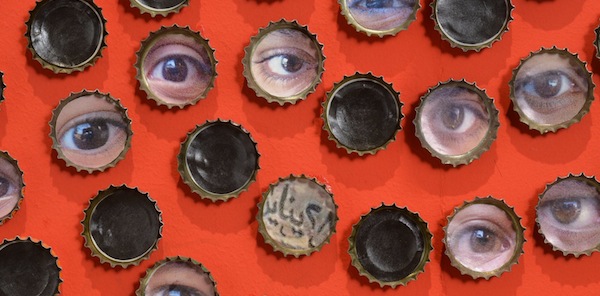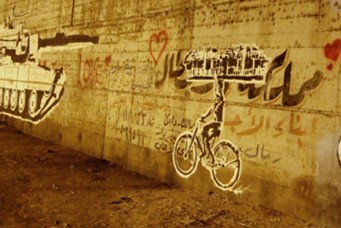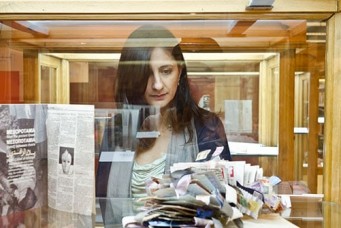Concept Pop
Pop Art is fun. But does it embody meaning? The same question can be asked of higher-brow Concept Art. Some Egyptian artists are taking objects like soda cans and bottle caps and making statements relevant to the masses. It could change everything.

Discarded, 2012, by Huda Lutfi. Barry Iverson
We are all the protagonists of our own lives. Everything we do is in the first person. But how many of us are active participants in these lives of ours? I think it’s fair to say that most of us don’t really do much other than look out the window. We let the world around us write our scripts for us rather than the other way around.
A relatively established artist friend of mine once advised me to stop making work about the Egyptian revolution, stating that it is way too early for that kind of work, that we need to wait forty years before being able to do this sort of work. This to me signifies the mindset of your typical window gazer; someone who spends their life watching and commenting rather than participating. In terms of art, it signifies art that delivers commentary from a safe distance, as opposed to the kind of art that is very participatory. Not in the sense of the audience participating in the creation of the art, but rather art that participates in dealing with the immediate struggles and concerns of the audience.
The minute I walked into Hany Rashed’s exhibition Toys at Mashrabia Gallery, the words “concept pop” zapped themselves into my brain. The gallery on Champollion Street in downtown Cairo—which is mainly associated with showing art of a relatively traditional nature—was filled with what look like plastic depictions of things from our real world: two guys sitting on a public bench; a kid popping a wheelie on a motorcycle; a potato chip company’s delivery truck. These objects have very little in common with the meaningless yet very well-made action figures of the artist known as Sucklord. Unlike Sucklord’s figures, you can’t really play with Hany Rashed’s toys, which are mainly illustrations on plastic attached to cardboard after being subjected to heat, stretched out, and distorted. Also unlike Sucklord’s work, Hany Rashed’s objects come with meaning.
The minute you walk into this exhibition space littered with these toy-like objects, you get the message right away. The entire space is some kind of representation of the world we live in, except everything is made of plastic. Some come in packages, while others stand freely. What they all have in common though is that they are plastic and they are distorted. There’s something about seeing an accurate depiction of a public bus, except with the proportions all distorted and weird. Without needing walls of text to spoon-feed me the artist’s concept, without the curators giving me a special tour of the work, I get it. I understand that the artist is telling me that the world we live in is fake and unreal. While Sucklord focuses only on taking characters from pop culture, mainly Star Wars, and reducing them into action figures for no other reason than some kind of fanboy fixation, Hany Rashed creates toy-like objects of real life things, and in doing so, delivers his audience a message concerning their real world lives. Sucklord’s work is meaningless Pop Art. Hany Rashed’s work on the other hand uses Pop Art aesthetics in service of a very particular concept. He creates Concept Pop.
Fame and Perversity
Whoa, whoa, whoa! Did he just call Pop Art meaningless? asks a disgruntled reader. Yes, yes I did, Mr. Reader. Although Pop Art is sometimes cited as an art movement that has managed to bring art to the masses, that could not be further from the truth. In reality, what it has really done is take the commodities and aesthetics of the masses, repackage them, and sell them as fine art to elites existing in a small art-buying bubble. At the 1960s peak of celebrity fixation, heightened consumerism, and comic book sales in the millions, it might have made sense for artists in gallery circles to ride the wave with Pop Art. In today’s world however, where there is a backlash against the dominance of corporations, and more young people are eager to find their brand-less goods and organic products, where social media networks have made more relevant celebrities out of our friends and friends of friends, Pop Art—as we’ve known it—has no place.
Neither does so-called Conceptual Art, an art form that tends to be described as one in which the ideas take precedence over the aesthetics, but in reality tends to suffer from a lack of ideas as well. The end result being something that doesn’t necessarily look interesting, and nor is it really about anything. Marcel Duchamp’s commentary on his ridiculously famous Fountain urinal affirms that more than ever: “My idea was to choose an object that wouldn’t attract me, either by its beauty or by its ugliness. To find a point of indifference in my looking at it, you see.”
It is entirely perverse for the guy who took a urinal and uselessly hung it upside down in an art gallery to be far more famous than the guy who actually invented the urinal for its very functional purpose, one that is in fact useful to billions of people the world over. It is equally perverse for most major art institutions around the world today to treat this so-called art form as something avant-garde and cutting edge when it is in fact something that was officially introduced to this world back in 1917. What is most perverse of all is that there are a bunch of thirty-something artists in Egypt today who think of themselves as cutting edge for adopting a 1917 art form that most Egyptians do not relate to—they adopt it anyway out of an urge to appeal to art institutions centered in Europe and the USA.
Such an art form has no place in Egypt’s revolutionary climate. Although many Westerners may want to believe that Egyptians revolted against our regime out of a desire to adopt more “Western” values—or Western products, as was suggested by French author Guy Sorman in a public debate with me in 2011—in fact Egyptians were revolting against a bad regime that had taken much of its legitimacy from other world powers while simultaneously revolting against the conformist traditions of older generations. What the Egyptian people sought was independence in its truest form. Although Egyptians have obviously failed badly at achieving that (for now), it does not mean that the effects of the revolution should not find their way into art and culture. Conceptual Art in Egypt, with its compass oriented to point north-west, proves itself to be a rather anti-revolutionary art form. Which could very well explain the rise of Concept Pop.
Huda Lutfi’s Cut and Paste exhibition in 2013 at the Townhouse Gallery is worth discussing in this regard. The show was massive, occupying the gallery’s entire Factory space and included everything from installations to video to traditional collages; you name it, it was all there. And there was a lot of it. Two of Lutfi’s pieces, however, stood out as powerful works of Concept Pop: Discarded and Fool’s Journal. Discarded, an installation of hundreds of eyes staring back at you from the insides of soda-pop caps fixed on a red wall in circular formations, very poignantly comments on the nonchalant eye-snipering of protestors during the clashes on Mohammed Mahmoud Street. Clashes that have been taking place in a cyclical fashion since they first broke out on November 19, 2011.
With Fool’s Journal, Lutfi managed to create something that relates to the aesthetics of international contemporary art practices while having very particular cultural connotations in the Egyptian context: a number of cone-shaped hats made out of a collage of Egyptian newspapers. Cone-shaped hats in Egypt are known to be hats for fools. In wanting to say that Egyptian media is making fools out of people, Lutfi managed to pull it off smoothly without any kind of mucking around. The installation had the clean minimalism associated with contemporary art shows today, while delivering something that your average Egyptian can instantly “get” and relate to.
Lutfi has been making art for over twenty years. A lot of her work has been in the vicinity of your average collage work or your usual contemporary-art-styled installation that is difficult to decipher without additional wall text. For this artist to make the move to Concept Pop tells us something about this unique moment we’re living in and why a change in art practice today is absolutely vital.
Rock ‘n’ Roll
Ever since the revolution began in 2011, mainstream media has focused on the rise of street art in its very superficial sense: art on the street protesting the regime. At the same time, it has overlooked the qualities that are very specific to Egyptian street art: void of the artist’s ego and tackling concerns of your average Egyptian. It is these qualities that are finding their way into the works of conceptual artists and resulting in this new thing called Concept Pop.
Naturally, most people creating Concept Pop don’t even know they’re creating Concept Pop. Like early Punk Rock musicians who thought they were making rock ‘n’ roll. Ramones drummer Tommy Ramone is quoted as saying, “In its initial form, a lot of [1960s] stuff was innovative and exciting. Unfortunately, what happens is that people who could not hold a candle to the likes of Hendrix started noodling away. Soon you had endless solos that went nowhere. By 1973, I knew that what was needed was some pure, stripped down, no bullshit rock ‘n’ roll.” Little did he know that he was one of the people laying the groundwork for an entirely new genre of music altogether.
In 2013, Ahmed Hefnawy built one of the most immersive art installations in modern Egyptian history. On a December night at the abandoned Viennoise Hotel in downtown Cairo owned by Ismailia Real Estate Company, a trail of tear gas, suspended in the air, made its way across one of the rooms, bouncing off the walls multiple times until it hit the floor and spiraled in place. At the end of the trail was one of Hefnawy’s “tear gas canisters” made from juice cans. This was a recreation of a real-life scene many Egyptians have become all too familiar with. In real life though, when a tear gas canister is sent flying in the air, you can’t help but panic and run for your life. Or perhaps the hero inside comes to life and you rush toward the canister just to hurl it back at the security forces.
In Hefnawy’s installation, however, you had the opportunity to examine and contemplate the moment. You could get as close to his sculpture as you wanted. You could touch it or feel it. Another one of Hefnawy’s pieces froze the moment of a canister ejecting from a shotgun inside a museum-style glass box. I was there in Tahrir Square when the first tear gas canister was shot into the air. Everyone present paused for a split second in an attempt to understand what that thing was. It wasn’t long before crowds were running all over the place without being given the opportunity to understand the situation. Hefnawy gave his audience the opportunity to examine that moment in one’s own time, an opportunity to be saddened and hurt by it, exemplified by the tears in the eyes of many viewers at the art show. An art show that gathered hundreds of viewers on its opening night, many of whom confessed they had never been to an art show before.
The following days would witness crowds of young folk waiting outside the doors of the space before opening hours, eager to see what all the fuss was about. This was, by the way, during the last week of December, a period seen as box office poison by the gallery circles, as most regular art enthusiasts are typically off on vacation. Hany Rashed, who is used to holding exhibitions at Mashrabia Gallery just down the street from the abandoned Viennoise Hotel, was most surprised. “I’ve never seen this much enthusiasm or attendance for my art openings at Mashrabia Gallery, even during what are considered peak seasons, even though Mashrabia and the Viennoise are in pretty much the same location.” He told me this while drinking real juice out of one of the canisters, which Hefnawy had made available in a glass-door fridge, like the ones commercially used by soda companies. Many visitors of the exhibition were downing their tear-gas juice while examining the work, a symbolic challenge to assault by the state.
Outside the Bubble
It’s not like it’s necessary for a work of Concept Pop to be revolution-themed. One powerful work of Concept Pop was created by Alexandrian artist Mahmoud Khaled back in 2007, four years prior to the #Jan25 revolution. In MKMAEL Stories—an Image Passionate, Khaled published a little storybook aesthetically akin to cheap romance novellas sold on the sidewalks of Egyptian cities. In it, Khaled printed an online chat archive between himself and another man. Throughout the chat, a strong tension could be felt, a tension between wanting to get closer to someone and needing to remain unattainable. The result is a contemporary take on romance stories for the digital age, one that brings about emotions that are as piercing as any classic romance story. It is a work that Khaled exhibits in his white cube gallery openings, but it is one that utilizes a visual language common to the average Egyptian—the romance novella and the online chat format—in favor of a very particular concept. Although it is a personal story, it has the power of communicating to an average person, one who is not used to visiting art galleries, the similarities between homosexual and heterosexual romance. The work is about something concerning more than just those operating within the limited gallery bubble, while incorporating techniques that would be considered Conceptual as well as Pop. It is undeniably a great work of Concept Pop.
Mahmoud Khaled, Ahmed Hefnawy, and Huda Lutfi probably don’t even know that they’ve created Concept Pop. The same way the Velvet Underground, the Ramones, and the Kinks thought they were making some form of rock ‘n’ roll, many Concept Pop artists will think they’re making either a work of Conceptual Art, Pop Art, or Street Art. There will be plenty of nay-sayers out there; traditionalists who will refer to works of Concept Pop as too direct or not real art. But before they know it, Concept Pop will be the thing, and much like Punk, it will change everything.
Ganzeer is the pseudonym of an Egyptian artist. He is not an author, comic artist, installation artist, painter, speaker, street artist, or videographer, though he has assumed these roles in a number of places around the world. His art has been shown in Bahrain, Belgium, Brazil, Canada, Finland, Germany, Jordan, the Netherlands, Switzerland, United Arab Emirates, and the United States, as well as in myriad Cairo galleries. Art in America has referred to Ganzeer’s work as “New Realism,” and the Huffington Post ranked him among the “25 Street Artists from Around the World who are Shaking Up Public Art,” but Ganzeer rejects both labels. He regards Bidoun magazine’s description of him as a “contingency artist” as probably the most accurate. More information about his work is available at ganzeer.com. On Twitter: @Ganzeer.




